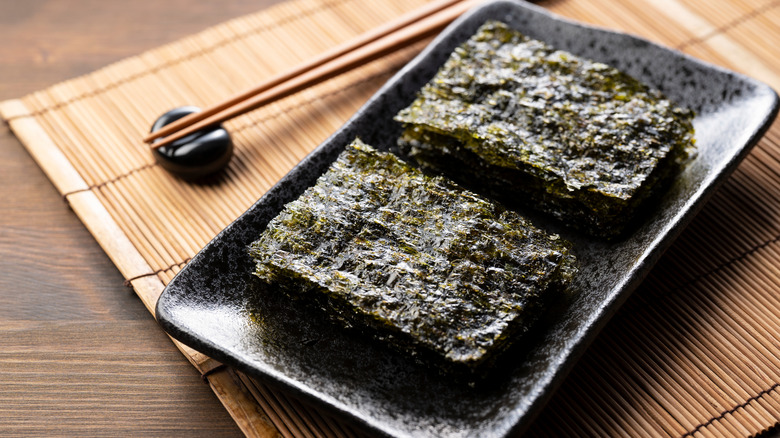Elevate The Flavor Of Kimbap By Toasting The Seaweed
Kimbap is arguably one of the finest offerings of Korean cuisine. A harmonious blend of flavors and textures, these seaweed-wrapped rice rolls delight the palate while highlighting the natural tastes of the ingredients. It's no wonder they are a staple Korean dish, found everywhere from restaurants and diners to home dining tables and school lunches.
Although kimbap is ubiquitous, it truly shines when homemade, as this allows for extensive customization and adjustments. One quick, easy modification you can make that will guarantee an impactful flavor boost is toasting the seaweed beforehand. This intensifies its natural umami notes and adds noticeable depth — just enough to envelop the kimbap in a rich layer of flavor without overwhelming the other ingredients. Moreover, the toasting imparts a cozy, burnt aroma that comes as a package deal with toasted foods. This adds a complex sensory dimension to the dish, engaging both your taste buds and your sense of smell. As a bonus, toasted seaweed also lends a delightful crispiness to your kimbap, contrasting beautifully with the tender rice and fillings inside. This ensures that the rolls maintain their integrity and don't become overly soggy or easily fall apart — qualities essential for good kimbap.
What to know when you're toasting seaweed
While pre-made toasted seaweed sheets are widely available, toasting your own at home yields a much better flavor payoff and gives your nori sheets a delicious crisp. A light sprinkle of salt before toasting usually suffices, but you can also add other seasonings like paprika, pepper, or garlic powder for a subtle kick of heat and added nuances in the final dish.
On the stovetop over medium heat, it should take no longer than one minute to toast your seaweed to a brittle crisp. Lightly rub a small amount of oil on the surface, then gently press it onto the pan. Toast for around five seconds on each side, adjusting for the size of the sheets and cooking temperature. In the oven, the sheets should take around five minutes to reach a moderate level of crispiness suitable for wrapping kimbap.
As soon as the seaweed's color starts to lighten and it begins to puff up, carefully remove it from the pan. With such a short cooking time, it's crucial to keep a close eye on it to prevent it from becoming too crispy and breaking when wrapped later on. Another important step is to let the toasted seaweed sheets cool for a few minutes after they come off the stove or out of the oven. This will give them time to settle, ensuring they won't crumble when you work with them.

